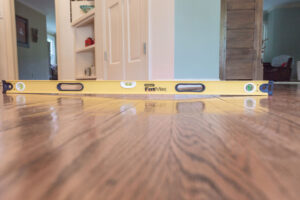 Sagging and Soft Floors in Mobile Homes are one of the most common problems with mobile homes. It represents about 20% of our business every year. Many of the cause are avoidable, i.e. vapor barriers that are damaged and allow moisture and mold into the mobile home. Water damage is also avoidable and we’ll discuss these problems and more in this article. We hope this helps you to avoid soft and sagging floors.
Sagging and Soft Floors in Mobile Homes are one of the most common problems with mobile homes. It represents about 20% of our business every year. Many of the cause are avoidable, i.e. vapor barriers that are damaged and allow moisture and mold into the mobile home. Water damage is also avoidable and we’ll discuss these problems and more in this article. We hope this helps you to avoid soft and sagging floors.
Mobile homes can develop issues such as sagging and soft floors, which can pose safety hazards and compromise the overall integrity of the home. Understanding the causes of these problems is crucial in order to address them effectively. This article aims to explore the common causes of sagging and soft floors in mobile homes. We’ll be providing you with valuable insights into prevention and solutions.
Two of the main causes of soft and sagging floors
- Age and Wear: One of the primary factors contributing to sagging and soft floors in mobile homes is the natural aging process. The materials used in the construction of the home, such as floor joists and subflooring, can deteriorate and become warped. Continuous foot traffic, moisture exposure, and the weight of furniture can accelerate this process.
- Moisture and Water Damage: Moisture is a major culprit behind sagging and soft floors in mobile homes. Water intrusion from plumbing leaks, roof leaks, or excessive humidity can cause wood rot, decay, and warping of floors. When moisture gets in subflooring or floor joists, they lose their strength and stability, leading to sagging and softness in the floors.
Improper Foundation Support:
The foundation of a mobile home plays a critical role in maintaining its structural integrity. Inadequate or improper support can result in uneven weight distribution, leading to sagging and soft floors. Insufficient piers, settling of the foundation, or the absence of perimeter support can all contribute to this problem. In some cases, the soil beneath the mobile home may not be properly prepared or compacted, causing the foundation to sink and the floors to sag.
- Excessive Weight and Overloading: Mobile homes have specific weight-bearing capacities, and exceeding those limits can cause structural issues. Placing heavy furniture, appliances, or objects in concentrated areas can overload the floor joists and lead to sagging or softness. Changes made to the home without considering the load-bearing capacity, such as removing walls or adding extensions, can place undue stress on the floors and contribute to the problem.
- Inadequate Maintenance and Repairs: Neglecting routine maintenance in your home can cause sagging and soft floor problems in mobile homes. Lack of attention to plumbing leaks, roof leaks, or other sources of moisture can allow the problem to persist and worsen over time. Similarly, delaying repairs to damaged subflooring or weakened floor joists can cause the problem to spread to larger areas
Conclusion: Sagging and soft floors in mobile homes can be a significant concern, affecting the comfort, safety, and structural integrity of these structures. By understanding the causes of these problems, homeowners can take proactive measures to prevent them from occurring or mitigate their impact. Regular maintenance, addressing moisture issues promptly, ensuring proper foundation support, and staying within weight-bearing limits are crucial for maintaining the structural stability of mobile homes. Seeking professional assistance for repairs and renovations is advisable to ensure the work is done properly and to prevent further damage. With proper care and attention, mobile homeowners can ensure their homes remain safe and comfortable for years to come.